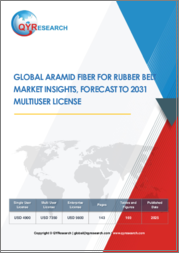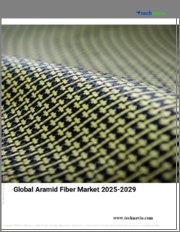
|
연간정보 서비스
상품코드
1225838
세계의 아라미드 섬유 시장 분석 : 플랜트 생산능력, 생산, 운영 효율, 수요 및 공급, 최종사용자 업계, 유형, 판매채널, 지역 수요, 외국 무역, 기업 점유율(2015-2030년)Global Aramid Fiber Market Analysis: Plant Capacity, Production, Operating Efficiency, Demand & Supply, End-User Industries, Type, Sales Channel, Regional Demand, Foreign Trade, Company Share, 2015-2030 |
||||||
세계의 아라미드 섬유 시장 규모는 2021년 약 10만 톤인가, 2030년까지 약 14만 톤에 달하며, 예측 기간 중 CAGR로 3.99%의 성장이 예측됩니다.
세계의 아라미드 섬유 시장을 조사분석했으며, 시장의 개요, 부문별·지역별 분석, 기업 점유율 등의 정보를 정리하여 전해드립니다.
목차
제1장 생산능력 : 기업별
아라미드 섬유의 중요한 제조업체와 현재 및 향후 운영 효율에 관한 최신 정보를 실시간으로 입수할 수 있다.
제2장 생산능력 : 로케이션별
제조업체 위치 기반 능력 분석에 의해 아라미드 섬유의 지역 공급을 보다 깊게 이해한다.
제3장 생산 : 기업별
주요 기업에 의한 과거 아라미드 섬유의 연간 생산량을 조사했으며, 향후 수년간 어떻게 성장하는지 예측한다.
제4장 수요 : 유형별
아라미드 섬유(파라아라미드와 메타아라미드)의 유형과 이것의 수요에 대해 파악한다. 전략 설계시 어느 유형에 집중하는지 선택한다.
제5장 수요 : 최종 용도별
어느 최종사용자 업계(자동차, 안전·보호 기기, 전자·통신, 항공우주, 기타)가 시장을 형성하고 있는지, 아라미드 섬유 시장의 성장 예측을 발견한다.
제6장 수요 : 지역별
북미, 유럽, 아시아태평양, 중동·아프리카, 남미 등의 다양한 지역에서 아라미드 섬유의 수요 변화를 분석하고 지역의 수요 매핑을 지시한다.
제7장 수요 : 판매채널별(직접·간접)
아라미드 섬유의 판매에는 복수 채널이 사용된다. 업계 판매의 대부분을 대리점 및 딜러 또는 직접 판매가 차지하고 있는지 아닌지 분석하는데 도움이 된다.
제8장 수급 격차
아라미드 섬유의 무역흑자와 적자에 관한 정보를 얻기 위해 수급 격차를 결정한다.
제9장 기업 점유율
아라미드 섬유의 시장 점유율 중 현재 전 세계의 주요 기업이 차지하는 비율을 파악한다.
제10장 수출 : 국가별
주요 국가의 아라미드 섬유 수출량에 관한 상세를 취득한다.
제11장 수입 : 국가별
주요 국가의 아라미드 섬유 수입량에 관한 상세를 취득한다.
KSA 23.03.13The global Aramid Fiber market has expanded remarkably to reach approximately 100 thousand tonnes in 2021 and is expected to grow at a CAGR of 3.99% during the forecast period until 2030.
Aramid Fiber is the stronger version of polyamide 6 Fiber. It is industrially prepared by the chemical reaction between an amine group and a carboxylic acid halide group. Generally, spinning process is utilized for the preparation of Aramid Fiber. In their chemical structure, they have the connectivity of -(NH-C6H4-CO) n- group. They offer very high tensile strength, water-resistance, corrosion resistance, abrasion resistance, and mechanical properties due to linking in their structure. Furthermore, they show excellent stability at high temperature but melt at temperature greater than 500 degree They have various industrial applications like security and protection, Rubber & Tire Reinforcement, Frictional Material, Optical Fiber, and others Celsius. Aramid Fiber has a wide range of applications such as manufacture of ropes, cables, V-belts, heat-resistant coatings and clothing, snowboards, tennis springs, car tires, turbocharger hoses, train parts, disc brakes, belts, gaskets, clutches, seat fabrics, electronics, seat sensors.
The primary driver of Aramid Fiber global market is accounted by the Automotive sector. In 2021, approximately 30% of global Aramid Fiber was utilized by Automotive sector. This sector is which is anticipated to rise in response to rising demand of vehicles for transportation and travel purposes in the coming years. Due to its superior properties, like water-resistance, corrosion-resistance and stability at high temperatures, the global Aramid Fiber demand by the Safety & protection Equipment industry is also expected rise forecast period. The global Aramid Fiber is anticipated to expand and reach approximately 140 thousand tonnes by 2030.
Based on demand across the globe, the Asia Pacific happens to be the biggest consumer of Aramid Fiber. This region accounted with a demand of approximately 35% of the global Aramid Fiber in 2021. The demand for products in APAC is projected to be expand by growing industrialization and strong expansion of automotives for transportation of goods. The increasing spending on the military in major economies like India is anticipated further expand the usage of Safety & protection Equipment which is expected to further propel the demand of Aramid Fiber. North America is the second largest consumer of global Aramid Fiber. Furthermore, Asia Pacific is also taking the lead as a producer of this Fiber amongst all the other regions. In 2021, about 30% of the global Aramid Fiber production occurred in this region.
Based on type, the global Aramid Fiber market is segregated into Para Aramid and Meta Aramid. Para Aramid is the primarily sold in the market. It accounted for a demand of about 60% of the global Aramid Fiber market in 2021. Para aramid is used for hi-tech applications such as manufacture of bullet proof vests for military and police people.
Based on end-uses, the global Aramid Fiber market is segregated into Automotive, Safety & protection Equipment, Electronic & Telecommunication, Aerospace, and Others. Although, the Automotive industry is the dominating as a consumer industry for Aramid Fiber market. It is anticipated to remain the most significant consumer in forecast period. However, Safety & protection Equipment is also a close competitor as a consumer. The consumption of Aramid Fiber in the Aerospace industry is expected to soar in the forecast period where Aramid Fiber is used for making fuel tanks and doors.
Major players in the production of Global Aramid Fiber are E.I. du Pont de Numerous and company, Teijin Limited, Kolon Industries Inc., Yantai Taiho Advanced Material Co. Ltd, Hyosung Corporation, Toray Industries Inc., SRO Aramid, and Huvis Corporation.
Years considered for this report:
Historical Period: 2015- 2021
Base Year: 2021
Estimated Year: 2022
Forecast Period: 2023-2030
Objective of the Study:
- To assess the demand-supply scenario of Aramid Fiber which covers production, demand and supply of Aramid Fiber market in the globe.
- To analyse and forecast the market size of Aramid Fiber
- To classify and forecast Global Aramid Fiber market based on end-use and regional distribution.
- To examine competitive developments such as expansions, mergers & acquisitions, etc., of Aramid Fiber market in the globe.
To extract data for Global Aramid Fiber market, primary research surveys were conducted with Aramid Fiber manufacturers, suppliers, distributors, wholesalers and Traders. While interviewing, the respondents were also inquired about their competitors. Through this technique, ChemAnalyst was able to include manufacturers that could not be identified due to the limitations of secondary research. Moreover, ChemAnalyst analyzed various segments and projected a positive outlook for Global Aramid Fiber market over the coming years.
ChemAnalyst calculated Aramid Fiber demand in the globe by analyzing the historical data and demand forecast which was carried out considering the raw materials to produce Aramid Fiber. ChemAnalyst sourced these values from industry experts and company representatives and externally validated through analyzing historical sales data of respective manufacturers to arrive at the overall market size. Various secondary sources such as company websites, association reports, annual reports, etc., were also studied by ChemAnalyst.
Key Target Audience:
- Aramid Fiber manufacturers and other stakeholders
- Organizations, forums and alliances related to Aramid Fiber distribution
- Government bodies such as regulating authorities and policy makers
- Market research organizations and consulting companies
The study is useful in providing answers to several critical questions that are important for industry stakeholders such as Aramid Fiber s manufacturers, customers and policy makers. The study would also help them to target the growing segments over the coming years (next two to five years), thereby aiding the stakeholders in taking investment decisions and facilitating their expansion.
Report Scope:
In this report, Global Aramid Fiber s market has been segmented into following categories, in addition to the industry trends which have also been detailed below:
- Market by Type: Para Aramid and Meta Aramid
- Market, by end-use: Automotive, Safety & protection Equipment, Electronic & Telecommunication, Aerospace, and Others.
- Market, by Sales Channel: Direct Sale and Indirect Sale
- Market, by Region: North America, Europe, Asia Pacific, Middle East and Africa, and South America.
Available Customizations:
With the given market data, ChemAnalyst offers customizations according to a company's specific needs.
Table of Contents
Table of Content
1. Capacity By Company
On our online platform, you can stay up to date with essential manufacturers and their current and future operation capacity on a practically real-time basis for Aramid Fiber.
2. Capacity By Location
To better understand the regional supply of Aramid Fiber by analyzing its manufacturers' location-based capacity.
3. Production By Company
Study the historical annual production of Aramid Fiber by the leading players and forecast how it will grow in the coming years.
4. Demand by Type
Learn about the various types of Aramid Fiber- Para Aramid and Meta Aramid, and their demands. It will allow you to choose which type to concentrate on when designing your strategy.
5. Demand by End- Use
Discover which end-user industry (Automotive, Safety & protection Equipment, Electronic & Telecommunication, Aerospace, and Others) are creating a market and the forecast for the growth of the Aramid Fiber market.
6. Demand by Region
Analyzing the change in demand of Aramid Fiber in different regions, i.e., North America, Europe, Asia Pacific, Middle East and Africa, and South America, that can direct you in mapping the regional demand.
7. Demand by Sales Channel (Direct and Indirect)
Multiple channels are used to sell Aramid Fiber. Our sales channel will help in analyzing whether distributors and dealers or direct sales make up most of the industry's sales.
8. Demand-Supply Gap
Determine the supply-demand gap to gain information about the trade surplus or deficiency of Aramid Fiber.
9. Company Share
Figure out what proportion of the market share of Aramid Fiber is currently held by leading players across the globe.
10. Country-wise Export
Get details about quantity of Aramid Fiber exported by major countries.
11. Country-wise Import
Get details about quantity of Aramid Fiber imported by major countries.
(주말 및 공휴일 제외)


















